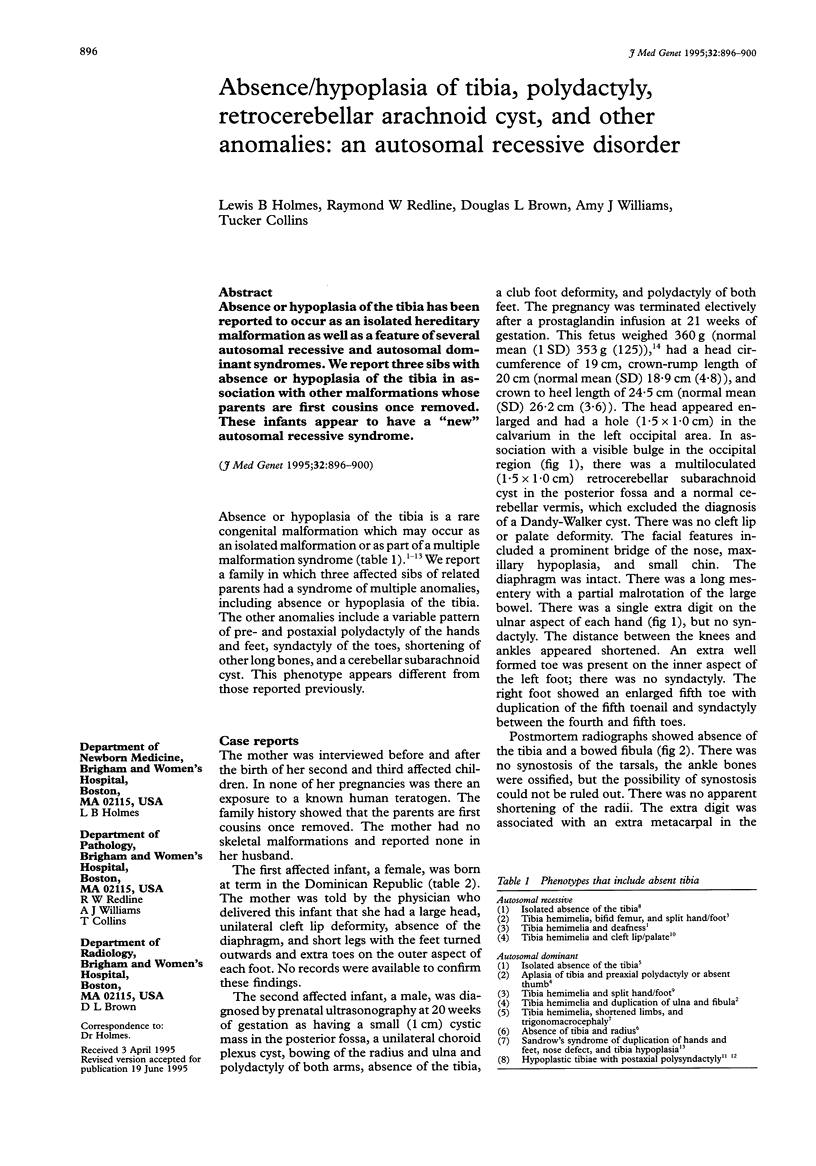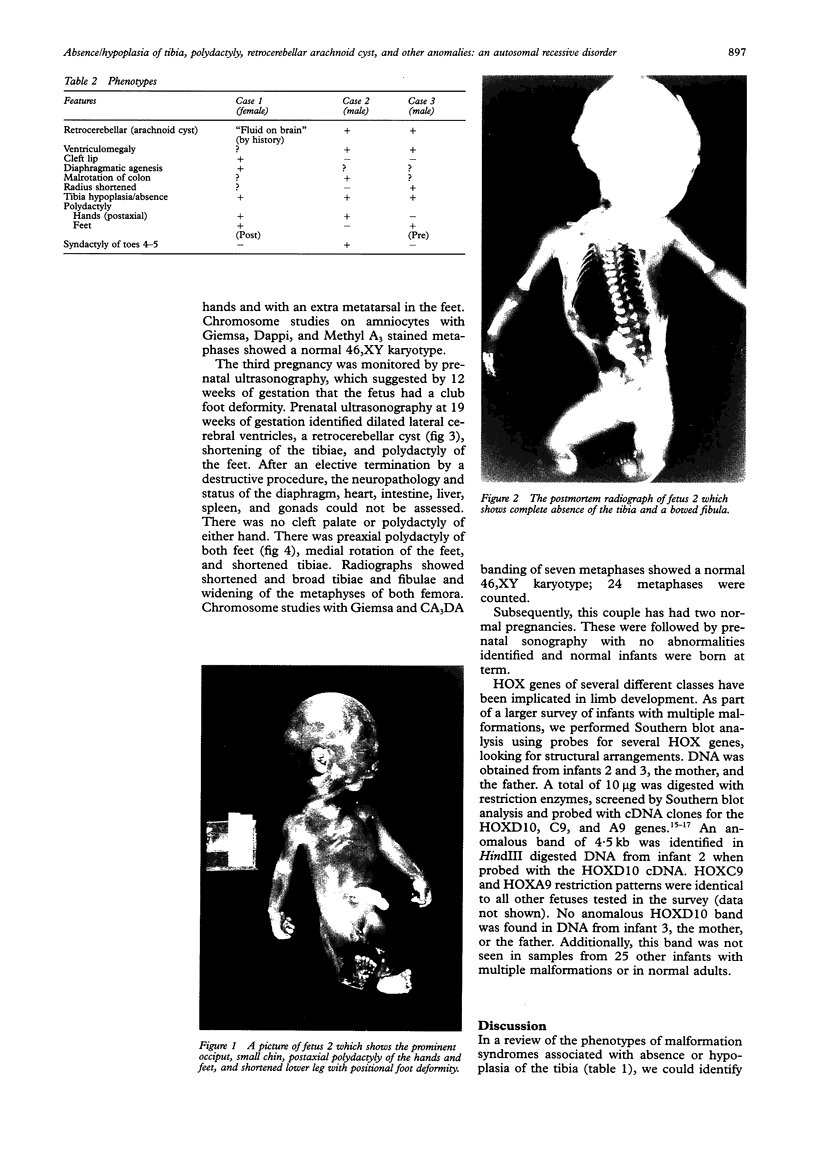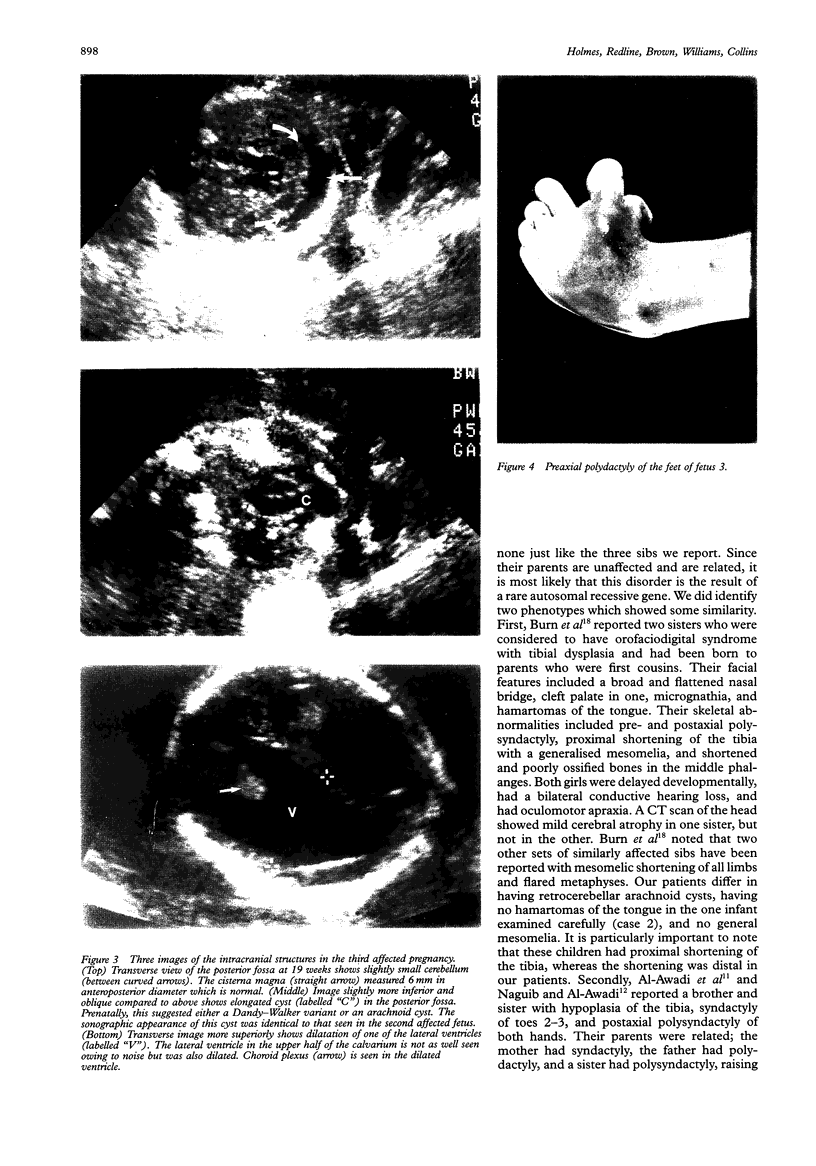Abstract
Absence or hypoplasia of the tibia has been reported to occur as an isolated hereditary malformation as well as a feature of several autosomal recessive and autosomal dominant syndromes. We report three sibs with absence or hypoplasia of the tibia in association with other malformations whose parents are first cousins once removed. These infants appear to have a "new" autosomal recessive syndrome.
Full text
PDF




Images in this article
Selected References
These references are in PubMed. This may not be the complete list of references from this article.
- Al-Awadi S. A., Naguib K. K., Farag T. I., Teebi A. S. Hypoplastic tibiae with postaxial polysyndactyly: a new dominant syndrome? J Med Genet. 1987 Jun;24(6):369–372. doi: 10.1136/jmg.24.6.369. [DOI] [PMC free article] [PubMed] [Google Scholar]
- Balling R., Deutsch U., Gruss P. undulated, a mutation affecting the development of the mouse skeleton, has a point mutation in the paired box of Pax 1. Cell. 1988 Nov 4;55(3):531–535. doi: 10.1016/0092-8674(88)90039-6. [DOI] [PubMed] [Google Scholar]
- Brown J. M., Wedden S. E., Millburn G. H., Robson L. G., Hill R. E., Davidson D. R., Tickle C. Experimental analysis of the control of expression of the homeobox-gene Msx-1 in the developing limb and face. Development. 1993 Sep;119(1):41–48. doi: 10.1242/dev.119.Supplement.41. [DOI] [PubMed] [Google Scholar]
- Burn J., Dezateux C., Hall C. M., Baraitser M. Orofaciodigital syndrome with mesomelic limb shortening. J Med Genet. 1984 Jun;21(3):189–192. doi: 10.1136/jmg.21.3.189. [DOI] [PMC free article] [PubMed] [Google Scholar]
- Clark M. W. Autosomal dominant inheritance of tibial meromelia. Report of a kindred. J Bone Joint Surg Am. 1975 Mar;57(2):262–264. [PubMed] [Google Scholar]
- Dollé P., Izpisúa-Belmonte J. C., Falkenstein H., Renucci A., Duboule D. Coordinate expression of the murine Hox-5 complex homoeobox-containing genes during limb pattern formation. Nature. 1989 Dec 14;342(6251):767–772. doi: 10.1038/342767a0. [DOI] [PubMed] [Google Scholar]
- Hui C. C., Joyner A. L. A mouse model of greig cephalopolysyndactyly syndrome: the extra-toesJ mutation contains an intragenic deletion of the Gli3 gene. Nat Genet. 1993 Mar;3(3):241–246. doi: 10.1038/ng0393-241. [DOI] [PubMed] [Google Scholar]
- Inagaki T., Garcia-Martinez V., Schoenwolf G. C. Regulative ability of the prospective cardiogenic and vasculogenic areas of the primitive streak during avian gastrulation. Dev Dyn. 1993 May;197(1):57–68. doi: 10.1002/aja.1001970106. [DOI] [PubMed] [Google Scholar]
- LAURIN C. A., FAVREAU J. C., LABELLE P. BILATERAL ABSENCE OF THE RADIUS AND TIBIA WITH BILATERAL REDUPLICATION OF THE ULNA AND FIBULA. A CASE REPORT. J Bone Joint Surg Am. 1964 Jan;46:137–142. [PubMed] [Google Scholar]
- Majewski F., Küster W., ter Haar B., Goecke T. Aplasia of tibia with split-hand/split-foot deformity. Report of six families with 35 cases and considerations about variability and penetrance. Hum Genet. 1985;70(2):136–147. doi: 10.1007/BF00273072. [DOI] [PubMed] [Google Scholar]
- Martin R. A., Jones M. C., Jones K. L. Mirror hands and feet with a distinct nasal defect, an autosomal dominant condition. Am J Med Genet. 1993 Apr 15;46(2):129–131. doi: 10.1002/ajmg.1320460205. [DOI] [PubMed] [Google Scholar]
- McKay M., Clarren S. K., Zorn R. Isolated tibial hemimelia in sibs: an autosomal-recessive disorder? Am J Med Genet. 1984 Mar;17(3):603–607. doi: 10.1002/ajmg.1320170308. [DOI] [PubMed] [Google Scholar]
- Naguib K. K., al-Awadi S. A. Hypoplastic tibiae with postaxial polysyndactyly in two sibs: further conformation of a new syndrome. Am J Med Genet. 1990 Apr;35(4):588–589. doi: 10.1002/ajmg.1320350429. [DOI] [PubMed] [Google Scholar]
- Pashayan H., Fraser F. C., McIntyre J. M., Dunbar J. S. Bilateral aplasia of the tibia, polydactyly and absent thumb in father and daughter. J Bone Joint Surg Br. 1971 Aug;53(3):495–499. [PubMed] [Google Scholar]
- Ramirez M., Hecht J. T., Taylor S., Wilkins I. Tibial hemimelia syndrome: prenatal diagnosis by real-time ultrasound. Prenat Diagn. 1994 Mar;14(3):167–171. doi: 10.1002/pd.1970140304. [DOI] [PubMed] [Google Scholar]
- Redline R. W., Hudock P., MacFee M., Patterson P. Expression of AbdB-type homeobox genes in human tumors. Lab Invest. 1994 Nov;71(5):663–670. [PubMed] [Google Scholar]
- Redline R. W., Neish A., Holmes L. B., Collins T. Homeobox genes and congenital malformations. Lab Invest. 1992 Jun;66(6):659–670. [PubMed] [Google Scholar]
- Redline R. W., Williams A. J., Patterson P., Collins T. Human HOX4E: a gene strongly expressed in the adult male and female urogenital tracts. Genomics. 1992 Jun;13(2):425–430. doi: 10.1016/0888-7543(92)90263-r. [DOI] [PubMed] [Google Scholar]
- Richieri-Costa A. Tibial hemimelia-cleft lip/palate in a Brazilian child born to consanguineous parents. Am J Med Genet. 1987 Oct;28(2):325–329. doi: 10.1002/ajmg.1320280209. [DOI] [PubMed] [Google Scholar]
- Stephens T. D., McNulty T. R. Evidence for a metameric pattern in the development of the chick humerus. J Embryol Exp Morphol. 1981 Feb;61:191–205. [PubMed] [Google Scholar]
- Takahashi T., Yamamoto M., Mochizuki Y. [4 cases of bilateral split-hand with bilateral atresia of the tibia in a family]. Seikei Geka. 1968 Jan;19(2):95–98. [PubMed] [Google Scholar]
- Vortkamp A., Gessler M., Grzeschik K. H. GLI3 zinc-finger gene interrupted by translocations in Greig syndrome families. Nature. 1991 Aug 8;352(6335):539–540. doi: 10.1038/352539a0. [DOI] [PubMed] [Google Scholar]
- Wiedemann H. R., Opitz J. M. Brief clinical report: unilateral partial tibia defect with preaxial polydactyly, general micromelia, and trigonomacrocephaly with a note on "developmental resistance". Am J Med Genet. 1983 Mar;14(3):467–471. doi: 10.1002/ajmg.1320140310. [DOI] [PubMed] [Google Scholar]
- Yokouchi Y., Sasaki H., Kuroiwa A. Homeobox gene expression correlated with the bifurcation process of limb cartilage development. Nature. 1991 Oct 3;353(6343):443–445. doi: 10.1038/353443a0. [DOI] [PubMed] [Google Scholar]






